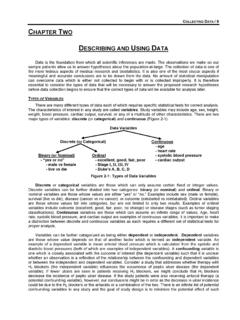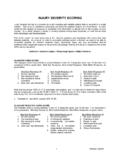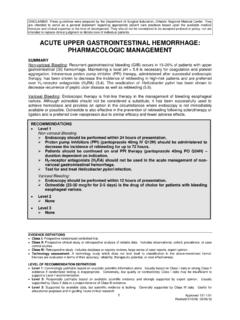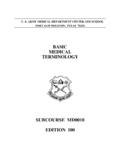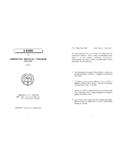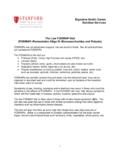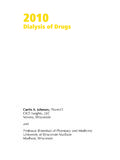Transcription of Massive Transfusion for Coagulopathy and …
1 DISCLAIMER: These guidelines were prepared by the Department of Surgical Education, Orlando Regional medical center . They are intended to serve as a general statement regarding appropriate patient care practices based upon the available medical literature and clinical expertise at the time of development. They should not be considered to be accepted protocol or policy, nor are intended to replace clinical judgment or dictate care of individual patients. Massive Transfusion for Coagulopathy and Hemorrhagic Shock SUMMARY. Exsanguination is a leading cause of early death following traumatic injury.
2 Recent studies demonstrate a survival benefit to protocol-driven Transfusion strategies that approach a 1:1:1 [packed red blood cell (PRBC), fresh frozen plasma (FFP), and platelet (PLT)] ratio in patients who require replacement of their total blood volume or greater in 24 hours or less. This resuscitation strategy improves patient survival, reduces hospital / intensive care unit (ICU) length of stay, decreases ventilator days, and reduces patient care costs. Recommendations are also provided for correction of coagulopathic hemorrhage. RECOMMENDATIONS.
3 Level 1: None Level 2. Administer blood products in a ratio of 1:1:1 (PRBC:FFP:PLT). In patients requiring Massive Transfusion of blood products, minimize crystalloid resuscitation to prevent dilutional Coagulopathy . Platelet transfusions are indicated in the following situations: Neurosurgical procedures or traumatic brain injury (TBI) with PLT count <100,000. Surgical / obstetric patients with microvascular bleeding and PLT count <50,000. Any surgical patient with PLT count <20,000. FFP (10-15 ml/kg) is indicated in the following situations: Hemorrhage with elevated PT or PTT (> times normal).
4 Urgent reversal of warfarin therapy (see Warfarin Reversal Guideline ). Cryoprecipitate should be administered in the following situations: Hemorrhage with fibrinogen concentrations <100 mg/dL. Bleeding patients with von Willebrand's disease. Tranexamic acid should be considered in patients with significant hemorrhage presenting within 3 hours of injury Level 3. Consider the Massive Transfusion Protocol (MTP) in the presence of: Systolic blood pressure 90 mmHg Heart rate 120 beats per minute (bpm). Positive focused sonography for trauma (FAST) exam pH Consider MTP implementation if transfusing 4 units of PRBCs over 1 hour or expected 10 units over 24 hours (more than one total blood volume).
5 Maintain platelet counts above 100,000 during times of active hemorrhage. o Correct moderate and severe hypothermia (<34 C). Place convective-air or aluminum space blankets over the patient. Use humidified mechanical ventilator circuits warmed to 41 C. Use fluid warmers for the infusion of fluids at 42 C. For refractory hypothermia, consider pleural/peritoneal lavage, or arterio- venous rewarming. Consider bicarbonate administration when pH < Consider use of recombinant Factor VIIa (Novoseven ) for refractory hemorrhage. EVIDENCE DEFINITIONS.
6 Class I: Prospective randomized controlled trial. Class II: Prospective clinical study or retrospective analysis of reliable data. Includes observational, cohort, prevalence, or case control studies. Class III: Retrospective study. Includes database or registry reviews, large series of case reports, expert opinion. Technology assessment: A technology study which does not lend itself to classification in the above-mentioned format. Devices are evaluated in terms of their accuracy, reliability, therapeutic potential, or cost effectiveness. LEVEL OF RECOMMENDATION DEFINITIONS.
7 Level 1: Convincingly justifiable based on available scientific information alone. Usually based on Class I data or strong Class II evidence if randomized testing is inappropriate. Conversely, low quality or contradictory Class I data may be insufficient to support a Level I recommendation. Level 2: Reasonably justifiable based on available scientific evidence and strongly supported by expert opinion. Usually supported by Class II data or a preponderance of Class III evidence. Level 3: Supported by available data, but scientific evidence is lacking.
8 Generally supported by Class III data. Useful for educational purposes and in guiding future clinical research. 1 Approved 05/25/2010. Revised 08/01/2012. INTRODUCTION. Patient mortality following traumatic injury has decreased over the past 30 years due to improved damage control procedures. Mortality rates continue to be elevated during the first hours following trauma center arrival, however, among patients with uncontrolled hemorrhage (1). This continued high mortality rate is attributable to ongoing hemorrhagic shock as a result of the self-perpetuating triad of Coagulopathy , acidosis, and hypothermia (2).
9 Measures to stop this process have long been a part of trauma resuscitation, including hypothermia management, surgical control of ongoing bleeding, and treatment of Coagulopathy with blood products. In the past decade, there has been a progressive trend towards increased use of blood products during trauma resuscitation, including plasma, platelets, and cryoprecipitate, due to the military experience with whole blood resuscitation in soldiers requiring Massive Transfusion . Massive Transfusion is universally accepted as the replacement of a patient's blood volume, or Transfusion of 10 units of PRBCs, over a 24.
10 Hour period (3-9). Similar damage control resuscitation is required in approximately 2-5% of civilian trauma. Such early intervention has been demonstrated to translate into a significant improvement in patient outcome (5-9). Damage control resuscitation is designed to treat Coagulopathy prior to its clinical manifestation, therefore stopping the self-perpetuating loop of coagulopathic hemorrhage or the deadly triad . The strategy of utilizing higher PRBCs:plasma:platelets ratios is not new and has been shown to have modest improvements in patient mortality (4-6).



